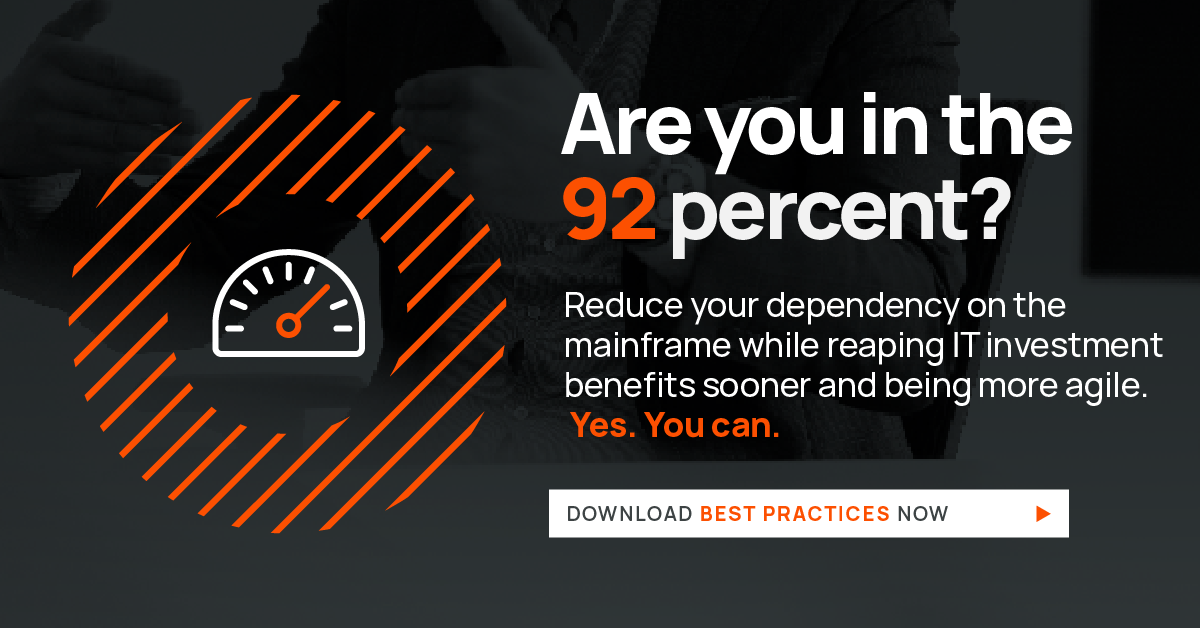A failure to understand the business value of technology transformation is an underlying impediment to very necessary change. Many organisations are reluctant to replace their ageing mainframe applications for fear of business disruption or finding the right replacement platform or technology or partner. But if they understood the value that modernisation would unlock, they may well become more proactive in advocating migration from the mainframe to a more sustainable platform like the Cloud.
Communication impasse
I have witnessed this communication impasse first-hand having spent half my working life in the business and the other half in the IT department. And I think it is a primary reason why companies continue to rely so heavily on mainframes, despite mounting evidence that they represent a risk to the business. True, mainframes have served corporations and institutions faithfully and well for decades. But their high operating costs and, more importantly, the impending skills shortages and outdated development models, represent a grave risk in current times.
But before we discuss how to create a shared language and mutual understanding, let’s first of all look at the differences between how value is perceived within IT and the business. An IT project ROI calculation is usually based on Project Investments compared with IT Operations Savings, especially when it’s about changing an ageing platform. The Business Value it can generate is not the most obvious part IT has in mind when it comes to requests for funding.
IT hobbled by finance perspective and reporting
The reasons for IT leadership remaining focused on cost-cutting activities, even in the digital-first, 21st century, are often structural: historically IT has reported to the finance chief whose mission remains reducing cost and improving efficiency. Business revenue-driven objectives, in contrast, set out to achieve a set of broader business outcomes.
Key elements in the calculation of the IT value are, typically:
- Usability: the overall quality of a user’s experience when interacting with software products.
- Functionality: the ability of a product to perform its intended work.
- Reliability: the capability of software to perform without interruption or errors that impede usability or functionality
- Performance: the accuracy and speed of a system or application
- Agility: the ability to respond to outside incentives such as pressure to change or adapt and the ability to create and respond to new opportunities.
Key elements in the calculation of the Business value, i.e., activities having a direct or indirect impact on company revenues, are:
- Business growth: exploiting new opportunities and capitalising on existing services.
- Customer experience: improving product capability to attract new customers and keep existing ones coming back.
- Agile business: adapting products to fluctuating market demands and tailoring products and services to meet customer needs.
- Smart operations: streamlining supply chains to bolster revenue.
Enable conversations that create value
Conversations about the exciting directions that a tightly coupled business and IT team could take the organisation and generate value might include: how to better serve the customer by harnessing cloud-based capabilities and technologies; how to better access market intelligence and prepare swifter responses to market trends by harmonising data across a global organisation; how to create bespoke value propositions for customers and segments by advanced data analysis; and how to speed up time-to-market and increase revenues with all of the above.
As the facilitator of application and mainframe modernisation, LzLabs regularly finds that it is the instigator of such conversations. Often, it’s as simple as encouraging and advising IT protagonists and partners to ask higher-level questions: Why do you want to launch a new product? Is it to reach new or different customers? Do you need to reduce inventory? Learning how to communicate about the broader value of IT helps foster transparency and break down the barriers that traditionally exist between IT and the rest of the business.
Build dialogue about value between stakeholders
A method that works well for LzLabs and its customers is to bring in an applications owner for every mainframe application that is migrated and modernised. This way, the intention for and potential of every business application is rigorously explored in the context of its business value. Once there is an understanding of the desired value — say, increasing sales by 5 or 10 percent — it is a matter for IT leaders to translate the answer into an action, enabled by a technical capability.
While these conversations will be varied and wide-ranging, leaving no stone left unturned if conducted well, there is a consistency to the technical capabilities delivered by modernisation projects. When LzLabs partners with clients, the technical outcome is to put legacy data at the disposal of organisations so that it is accessible and used in real-time. Our contribution is to make data available to the business in a way that is fast and cheap.
Articulate the value — generate funding
The final, and critical, piece of the modernisation programme is to quantify the business value that is returned on the technical delivery. Again, IT leaders must liaise with their business peers to successfully track the outcome of software products and services. While the business is adept at measuring value and putting KPIs on any service that is clickable, IT needs to gaze much further along the value chain than it would typically look.
Showing the big picture of what IT can accomplish in an organisation establishes its value with all key stakeholders. And, articulating the contribution that IT makes to value generation boosts confidence at the board, putting the holy grail within reach of modern IT – a constant drip of incremental investment.




